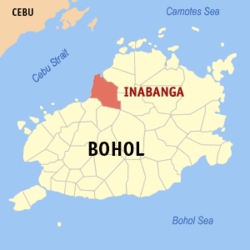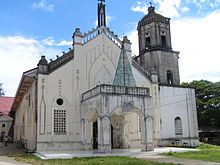Inabanga
Appearance
Inabanga | |
|---|---|
 Inabanga street | |
 Map of Bohol with Inabanga highlighted | |
| Country | Philippines |
| Region | Central Visayas (Region VII) |
| Province | Bohol |
| District | 2nd district of Bohol |
| Barangay | 50 (see § Barangays) |
| Government | |
| • Type | Sangguniang Bayan |
| • Mayor | Josephine Jumamoy (LP) |
| • Vice mayor | Rodrigo Jumamoy |
| • Municipal Council | Members |
| • Representative | Erico Aristotle Aumentado |
| Area | |
• Total | 125.63 km2 (48.51 sq mi) |
| Population (2020 census)[3] | |
• Total | 48,534 |
| • Density | 390/km2 (1,000/sq mi) |
| • Voter (2022)[4] | 24,338 |
| • Language | Boholano dialect Cebuano Eskayan Tagalog |
| Time zone | UTC+8 (PST) |
| ZIP code | 6332 |
| IDD : area code | +63 (0)38 |
| Income class | 3rd class |
| PSGC | 071224000 |
| Website | www |
Inabanga is a [[Template:PH plural of the Philippines#Income classification|3rd municipal income class municipality]] in the province of Bohol, Philippines.[2] According to the 2020 census, it has a population of 48,534.[3] Template:PH electorate
Geography
Land use:[5]
- Timberland area: 5,305 ha (13,110 acres)
- Mangrove area: 767 ha (1,900 acres)
- Alienable & Disposable (A & D): None
Soil cover:[5]
- Bantog clay
- Inabanga clay
- Bolinao clay
- Annam clay
- Hydrosol
Barangays
Inabanga comprises 50 barangays:
| PSGC | Barangay | Population | ±% p.a. | |||
|---|---|---|---|---|---|---|
| 2020[3] | 2010[6] | |||||
| 071224001 | Anonang | 1.5% | 748 | 721 | 0.37% | |
| 071224002 | Bahan | 1.3% | 651 | 464 | 3.44% | |
| 071224003 | Badiang | 2.2% | 1,085 | 1,083 | 0.02% | |
| 071224005 | Baguhan | 1.0% | 501 | 541 | −0.77% | |
| 071224007 | Banahao | 1.6% | 760 | 652 | 1.54% | |
| 071224008 | Baogo | 2.5% | 1,226 | 1,252 | −0.21% | |
| 071224009 | Bugang | 1.7% | 810 | 696 | 1.53% | |
| 071224010 | Cagawasan | 3.0% | 1,452 | 1,290 | 1.19% | |
| 071224011 | Cagayan | 0.9% | 429 | 390 | 0.96% | |
| 071224012 | Cambitoon | 2.3% | 1,132 | 919 | 2.11% | |
| 071224013 | Canlinte | 0.6% | 276 | 276 | 0.00% | |
| 071224014 | Cawayan | 2.0% | 969 | 1,147 | −1.67% | |
| 071224015 | Cogon | 1.7% | 820 | 865 | −0.53% | |
| 071224016 | Cuaming | 6.1% | 2,951 | 2,826 | 0.43% | |
| 071224017 | Dagnawan | 1.3% | 630 | 637 | −0.11% | |
| 071224018 | Dagohoy | 3.2% | 1,540 | 1,310 | 1.63% | |
| 071224019 | Dait Sur | 1.6% | 778 | 622 | 2.26% | |
| 071224020 | Datag | 1.4% | 661 | 559 | 1.69% | |
| 071224021 | Fatima | 1.8% | 861 | 721 | 1.79% | |
| 071224022 | Hambongan | 1.4% | 666 | 523 | 2.45% | |
| 071224023 | Ilaud (Pob.) | 1.8% | 861 | 954 | −1.02% | |
| 071224024 | Ilaya | 0.9% | 414 | 376 | 0.97% | |
| 071224025 | Ilihan | 0.9% | 414 | 398 | 0.39% | |
| 071224027 | Lapacan Norte | 0.8% | 396 | 350 | 1.24% | |
| 071224028 | Lapacan Sur | 2.4% | 1,187 | 1,217 | −0.25% | |
| 071224029 | Lawis | 2.7% | 1,297 | 1,389 | −0.68% | |
| 071224030 | Liloan Norte | 3.1% | 1,492 | 1,490 | 0.01% | |
| 071224031 | Liloan Sur | 2.4% | 1,165 | 954 | 2.02% | |
| 071224032 | Lomboy | 1.2% | 591 | 589 | 0.03% | |
| 071224033 | Lonoy Cainsican | 1.4% | 696 | 656 | 0.59% | |
| 071224034 | Lonoy Roma | 1.2% | 581 | 593 | −0.20% | |
| 071224035 | Lutao | 2.5% | 1,199 | 1,173 | 0.22% | |
| 071224036 | Luyo | 1.7% | 822 | 732 | 1.17% | |
| 071224037 | Mabuhay | 0.9% | 449 | 383 | 1.60% | |
| 071224038 | Maria Rosario | 1.6% | 764 | 424 | 6.06% | |
| 071224039 | Nabuad | 4.1% | 1,998 | 1,804 | 1.03% | |
| 071224040 | Napo | 1.5% | 728 | 706 | 0.31% | |
| 071224041 | Ondol | 2.3% | 1,107 | 1,122 | −0.13% | |
| 071224042 | Poblacion | 2.0% | 966 | 930 | 0.38% | |
| 071224043 | Riverside | 0.0% | 0 | 260 | −100.00% | |
| 071224044 | Saa | 1.3% | 619 | 634 | −0.24% | |
| 071224045 | San Isidro | 1.7% | 844 | 992 | −1.60% | |
| 071224046 | San Jose | 4.4% | 2,116 | 1,566 | 3.06% | |
| 071224047 | Santo Niño | 1.4% | 686 | 799 | −1.51% | |
| 071224048 | Santo Rosario | 2.3% | 1,117 | 997 | 1.14% | |
| 071224049 | Sua | 1.5% | 709 | 554 | 2.50% | |
| 071224050 | Tambook | 1.0% | 464 | 490 | −0.54% | |
| 071224051 | Tungod | 2.4% | 1,184 | 1,089 | 0.84% | |
| 071224052 | U‑og | 2.0% | 957 | 1,112 | −1.49% | |
| 071224053 | Ubujan | 2.3% | 1,111 | 1,064 | 0.43% | |
| Total | 48,534 | 43,291 | 1.15% | |||
Demographics

|
| ||||||||||||||||||||||||
| Source: Philippine Statistics Office[7][6][8] | |||||||||||||||||||||||||
Predominant religion: Roman Catholic
Economy

Annual Income (2014):[5] ₱68,144,172
Major industries:[5]
- farming
- fishing
- mat-weaving
- nipa thatch-making
Transportation
Total road length:[5] 130.60 kilometres (81 mi)
Total number of bridges: 8
Utilities

Water supply:[5]
- Main source of potable water: Groundwater
- L1 facilities – 489 water wells
- L2 systems in brgy Pob.
- L3 systems serving 22 barangays
- Potable water demand (1998): 73,230 cubic metres (19,000,000 US gal; 59 acre⋅ft) per day
Energization status (2010):[5]
- 50 barangays energized
- 8,710 actual household connections (98%)
- 8,900 potential house connections
Number of households with access to sanitary toilets: 7,686 (86%)
Tourist attraction

The North Bohol fault, which appeared during the 2013 Bohol earthquake, has become a tourist attraction in Bohol province.[9]
Local government
Welfare[5]
- Number of Barangay Health Stations: 28
- Number of Hospitals: None
- Number of Municipal Health Centers: None
- Number of Day Care Centers: 50
Education
Literacy rate: 92%
-
- North
- Cuaming HS
- Inabanga HS - Nabuad
- Inabanga North Integrated School
- San Jose NHS
- North
-
- South
- Dagnawan Integrated School
- Southern Inabanga HS
- South
Elementary and primary schools:[12]
-
- North
- Anonang ES
- Baogo ES
- Cambitoon ES
- Cuaming ES
- Dait Sur ES
- Datag ES
- Hambongan ES
- Inabanga North Integrated Sch.
- Lawis ES
- Liloan Norte ES
- Liloan Sur ES
- Nabuad ES
- Ondol ES
- San Isidro ES
- San Jose ES
- North
-
- South
- Banahao ES
- Cagawasan ES
- Cawayan ES
- Dagnawaan Integrated Sch.
- Dagohoy ES
- Inabanga South Central ES
- Lutao ES
- Sto. Rosario ES
- U-og Ubujan ES
- South
References
- ^ Municipality of Inabanga | (DILG)
- ^ a b "Municipal: Inabanga". PSGC Interactive. Quezon City, Philippines: Philippine Statistics Authority. Retrieved 8 January 2016.
- ^ a b c Census of Population (2020). "Region VII (Central Visayas)". Total Population by Province, City, Municipality and Barangay. Philippine Statistics Authority. Retrieved 8 July 2021.
- ^ "Number of Registered Voters by Sex : 2019 National and Local Elections" (PDF). Commission on Elections. 2019.
- ^ a b c d e f g h "Municipality of Inabanga". www.bohol.gov.ph. Official website of the Province of Bohol. Retrieved 19 December 2014.
- ^ a b Census of Population and Housing (2010). "Region VII (Central Visayas)" (PDF). Total Population by Province, City, Municipality and Barangay. National Statistics Office. Retrieved 29 June 2016.
- ^ Census of Population (2015). "Region VII (Central Visayas)". Total Population by Province, City, Municipality and Barangay. Philippine Statistics Authority. Retrieved 20 June 2016.
- ^ Censuses of Population (1903–2007). "Region VII (Central Visayas)". Table 1. Population Enumerated in Various Censuses by Province/Highly Urbanized City: 1903 to 2007. National Statistics Office.
- ^ Voltaire Tupaz (October 31, 2013). "Bohol's newfound fault: What's in a name?". rappler.com. Rappler. Retrieved 8 August 2016.
- ^ "List of High Schools". DepEd - Bohol. January 1, 2015. Retrieved 5 March 2015.
- ^ "Catholic Educational Institutions". Roman Catholic Diocese of Talibon. January 1, 2014. Retrieved 5 March 2015.
- ^ "List of Elementary Schools". DepEd – Bohol. January 1, 2015. Retrieved 5 March 2015.
External links
Wikimedia Commons has media related to Inabanga.
